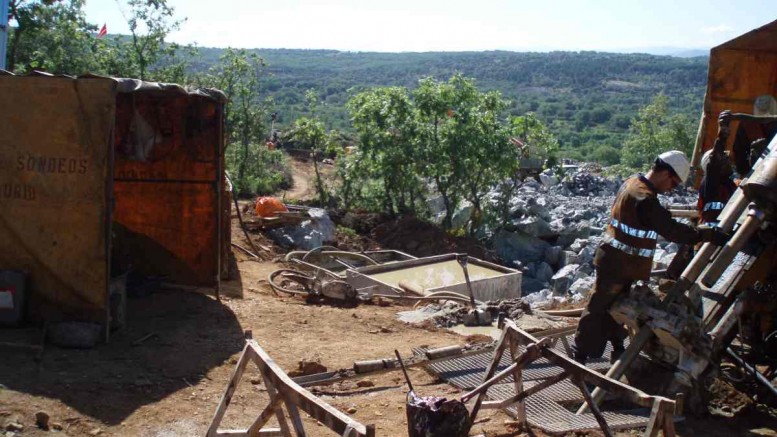Almonty Industries (AII-V) may be a relative newcomer to the TSX Venture Exchange — it listed just nine months ago — but the junior tungsten producer is probably better known in the industry for its depth of management.
CEO Lewis Black was previously CEO of Primary Metals (PMI-V). Along with Daniel D’Amato, a director at Almonty Industries who also worked at Primary Metals, Black structured a deal in 2008 to sell Primary Metals to Japanese metal conglomerate Sojitz for a price 20 times earnings — or a thirty-fold return on investment over three years.
Now Black and his team at Almonty are advancing exploration, development and production activities at the Los Santos project, a producing tungsten mine it acquired last September in western Spain, 50 km from Salamanca. The mine is also 255 km northeast of the Panasqueira tungsten mine, which Primary Metals sold to Sojitz Tungsten Resources.
For the full year ended September 2011, the Los Santos mine, which started production in 2008, produced 61,599 metric tonne units of tungsten concentrate. In the first quarter of 2012, Los Santos produced 16,889 metric tonne units of tungsten concentrate.
Jonathan Lee, an analyst at Byron Capital Markets who has a “speculative buy” rating on the stock and a target price of $1.25 per share —Almonty traded at $1.02 at presstime, within a 52-week range of 61¢–$1.23 — since taking over the mine last September, overall recoverable yields have moved from 45.5% prior to their arrival to the current 57%.
In a research note to clients on June 12, Lee says he believes there is potential to increase recoverable yields to generate better margins, because Almonty plans to spend additional capital on equipment. The company has ordered a new flotation cell, which it expects to install by September, and it has already installed a hydrosizer — which uses a stream of water to isolate and remove heavier, coarse impurities.
The purchases could increase yields to more than 70%, which could in turn boost production and revenues, cut operating costs and increase earnings, Lee reasons. For its part, Almonty forecasts it can reach recoveries of 65% by Dec. 31, 2012.
“In the near-term, the installation of the hydrosizer should lower operating costs starting in second-quarter 2012,” Lee argues. “By fourth-quarter 2012, we believe the installation of the flotation cell will increase yields to 72%, driving operating costs down from US$190 per tonne currently.”
The mine life of Los Santos extends into 2017, but the company plans to lengthen that lifespan through a four-year drill program that could add total 28,000 metres.
With drilling estimated at a cost of $145 per metre, Lee forecasts the company will spend $1 million a year on its expansion program. “For each year of resource added, we expect Almonty to add cash flows of up to $12.5 million a year,” he continues. “This is significant for a company that has a current market capitalization of less than $40 million.”
Drilling this year will be infill “to upgrade the resource and optimize the mine plan,” Lee explains, but subsequent drill programs in 2013, 2014 and 2015 “will expand the resource along strike and at depth.”
Los Santos has proven and probable reserves as of Dec. 31, 2010, of 1.76 million tonnes grading 0.33% tungsten trioxide (WO3) for 5,823 tonnes of WO3. Measured and indicated resources stand at 1.85 million tonnes grading 0.35% WO3 for 6,554 tonnes of WO3, while inferred resources tally 1.29 million tonnes at 0.29% for 3,790 tonnes of WO3.
As a producer, Almonty is benefiting from high tungsten prices, Lee adds. APT tungsten is trading at US$400 per metric tonne unit, although in the past year it has reached as high as US$450 per metric tonne unit. According to Lee’s estimates, the company receives 80% of the APT tungsten price through its current offtake agreement because it produces tungsten concentrate — “a precursor to the typical APT tungsten price.”
Almonty bought Los Santos for $14.4 million in cash, 5.56 million shares and 3.7 million warrants at an exercise price of $1.25 per share, Lee adds, noting that the mine originally opened for a total cost of A$70 million ($71.8 million) by Heemskirk Consolidated.
Los Santos is accessible by paved road and the mine is powered by diesel generators, but the company is looking into hooking up the site to the national electrical grid to the site to further cut costs.
The company has 37 million shares outstanding and 5.8 million options and warrants. “With positive cash flows that more than cover G&A and a drilling program to increase the resource,” Lee concludes, “we do not expect Almonty to dilute shareholders to expand the Los Santos project . . . earnings growth will only deliver better shareholder value.”
Tungsten became a strategic metal during the Second World War because its resistance to high temperatures and ability to strengthen alloys made it an important raw material for the arms industry. Demand for tungsten in the toolmaking and industrial equipment industry took off during the post-war industrial boom. Tungsten is alloyed with carbon to create tungsten carbide, which is used in high-speed manufacturing and machine-cutting tools, and has the highest melting point of all metals. It is harder than steel, and is one of the densest elements.


Be the first to comment on "Almonty Industries: Black’s second act?"